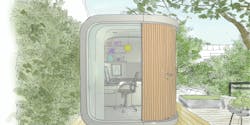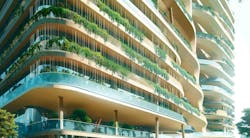6 ways to integrate nature into the workplace
The very first buildings—and those for thousands of years after—were designed to shelter us from the elements. Walls, roofs, windows and heating systems overcome the unpredictability of nature by keeping it outside. Before buildings, however, our bodies grew so accustomed to the natural environment that our health still depends on our exposure to it. Time spent in nature yields measurable value to our lives, improving cognitive function, increasing creativity and decreasing stress. Yet despite its many benefits, incorporating nature into the built environment remains a challenge.
For example, even though some European hospitals integrate nature into their buildings, hospitals in North America are often required to eschew greenery indoors due to code requirements. Like healthcare buildings, the modern corporate office also acts as a barrier to nature, removing workers from green space and making it difficult to open a window or step outside. And although the pandemic and subsequent shift toward remote and hybrid work provide flexibility to embrace gardening, go for a walk, or at least gaze out a window throughout the day, many of us still spend much of our time indoors.
6 Ways to Create a Strong Connection to Nature in Any Workplace
Integrating nature in the workplace (and all buildings, for that matter) is critical to the well-being of employees, teams and organizations. Here are six drivers that borrow characteristics from the outdoors to integrate nature into every workday.
1. The Workplace Should Be Organic
Establishing biophilic drivers for decision-making early on in a project leads to the thoughtful development of a calmer and more productive atmosphere. According to neuroscience research done with NBBJ fellow and molecular biologist Dr. John Medina, human beings are biologically predisposed to require contact with natural forms. Implementing a color palette that is associated with our experiences in nature, such as blues, greens and oranges, can offer motivation or focus, while rounded edges can make us feel safer than sharp corners.
2. The Workplace Should Change Frequently
On an even larger scale, hubs such as outdoor amphitheaters with movable walls or landscaped indoor spaces can support a range of activities such as group classes like yoga, gardening or cooking. These multi-use spaces can also serve as a meeting area or a place of respite, and if done well in harmony with nature, can offer diverse spaces that use zero energy. In addition, companies can explore the use of prefabricated or modular units—“offices in a box”—that can be easily nestled within the surrounding landscape. Not only do these spaces serve as diverse, autonomous places for work and meetings, but they can also be designed to easily open and close depending on the weather.
3. The Workplace Should Be Green
We know the color green raises our cortisol levels, almost instantaneously reducing our stress. That same color also enables our brain to focus as it helps us relax. Lesser known is the improvement that plants can bring to our physical health through anti-fungal chemicals that boost immunity. Including greenery and plants in the office is the simplest way to bring nature into the workplace.
At Korean fintech company Hana Bank’s headquarters—which will soon break ground—staff and visitors will be exposed to the health benefits of nature via immersive landscapes that include sweeping plantings, plazas and gardens extending from the existing landscape. However, even smaller planters or living walls offer enough benefit to warrant plants being incorporated into the office at any scale.
4. The Workplace Should Be an Immersive Escape
While living plants are preferable since the act of caring for them has a positive effect on happiness and satisfaction, even images of nature—whether digital or still—can improve overall mood and concentration. According to University of Washington psychology professor Peter Kahn, simply looking at images of nature can relax and calm us, while also keeping us engaged.
Digital displays, either combined with natural elements or in place of them, can create an immersive experience. If possible, change the architectural program of the space to include a respite room that allows its user to be enveloped in digital sights and sounds of nature.
5. The Workplace Should Be a Threshold
One benefit of an office tower is the ability to optimize views and access to daylight. However, incorporating intuitive pathways to light and establishing moments to step outside make an even bigger difference in supporting employees’ circadian rhythms and overall health.
At the campus of a Zhejiang-based large internet company, each employee’s workspace is located less than a minute from outside green space, and all workstations are close to windows that overlook greenery and open to let in fresh air and natural ventilation. Similarly, smartphone maker vivo’s nature-infused headquarters will feature an elegant spiral of exterior gardens, providing every level with easy access to green space for work, as well as paths for exercise.
6. The Workplace Should Be an Instigator
Enacting policies and protocols that allow employees to take advantage of nature throughout the workday is also beneficial. Encourage walking meetings by providing suggested routes and the length of time it takes to complete them. Implement a video-optional policy for certain calls or meetings to allow people to take them outdoors.
Nature’s ability to support both mental and physical health in the workplace and beyond must not be overlooked. The well-being and engagement of employees is critical to an organization’s sustained success, especially now. Incorporating moments to connect with the natural world throughout the workday leads to a happier, healthier, more creative workforce and more successful, productive organizations.




